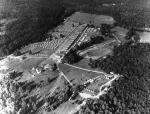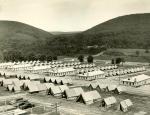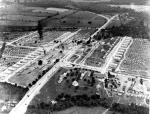![header=[Marker Text] body=[Authorized in 1929, first land bought in 1931, and first used by the National Guard in 1932. In 1940 it was leased to the Federal government as an Army cantonment. The total area is now more than 16,000 acres. ] sign](http://explorepahistory.com/kora/files/1/10/1-A-2D5-139-ExplorePAHistory-a0k4l5-a_450.jpg)
Mouse over for marker text
Name:
Indiantown Gap Military Reservation
Region:
Hershey/Gettysburg/Dutch Country Region
County:
Lebanon
Marker Location:
SR 4019, 1.3 miles N of U.S. 22 approaching Fort Indiantown Gap, Harper Tavern
Dedication Date:
March 1, 1947
Behind the Marker
For more than fifty years, the Pennsylvania National Guard (PNG) had trained at the State Military Reservation at Mount Gretna, a quaint little town that also hosted the Pennsylvania Chautauqua in Lebanon County. But by the 1920s, the PNG had outgrown Mount Gretna's 2,800-acre facility. Major technological advances in weaponry, including long-range artillery, aircraft, and motorized armored vehicles, had changed the nature and geographical range of modern warfare. And there were also growing concerns for the safety of the residents of the densely populated area immediately surrounding the post. So in 1929 the Pennsylvania State Legislature appointed a Military Reservation Commission, which soon concluded that the PNG needed more spacious accommodations for proper training in modern warfare.
State Military Reservation at Mount Gretna, a quaint little town that also hosted the Pennsylvania Chautauqua in Lebanon County. But by the 1920s, the PNG had outgrown Mount Gretna's 2,800-acre facility. Major technological advances in weaponry, including long-range artillery, aircraft, and motorized armored vehicles, had changed the nature and geographical range of modern warfare. And there were also growing concerns for the safety of the residents of the densely populated area immediately surrounding the post. So in 1929 the Pennsylvania State Legislature appointed a Military Reservation Commission, which soon concluded that the PNG needed more spacious accommodations for proper training in modern warfare.
In 1931, it identified a suitable site in northern Lebanon and Dauphin Counties that would meet the training requirements of an entire army division "for the next hundred years." Named after an Indian village formerly located at a gap in Blue Mountain, the new Indiantown Gap Military Reservation would offer safe and secure space for artillery firing and maneuvers, an ample water supply, and a capable transportation network.
In 1932, the state began to purchase what eventually totaled more than 18,000 acres for Indiantown Gap Military Reservation (IGMR). That summer, the 28th Division's 55th Artillery Brigade first used the reservation as a training facility. In 1934, the state began to erect new buildings through federally funded work relief programs. Soon, the Guard's new home included thirty-three buildings, a fifteen-square-mile artillery range, a fifteen-acre lake for amphibious training, and a grass landing field for small aircraft.
After the outbreak of World War II in 1939, the U. S. Army made plans for a major expansion in its troop strength. On September 30, 1940, the Federal Government leased Indiantown Gap Military Reservation from the Commonwealth of Pennsylvania for $1. Within days, construction crews began converting the tranquil National Guard post into an up-to-date facility to train men to fight a modern war. On February 17, 1941, President Franklin D. Roosevelt ordered the Pennsylvania National Guard's 28th Infantry Division into federal service. Within days, its men began occupying the new barracks buildings before they had even received a coat of paint.
28th Infantry Division into federal service. Within days, its men began occupying the new barracks buildings before they had even received a coat of paint.
Following the attack on Pearl Harbor and the U.S. entrance into the war, the New York Port of Embarkation on January 10, 1942, assumed jurisdictional control over IGMR, and the post became a staging area for what First Division lieutenant Joseph S. Freylinghuysen called the "hard-nosed business" of training for combat. To accommodate the 250,000 soldiers who would pass through IGMR on the way to the European battlefront, the federal government undertook a massive construction program that at its peak employed more than 13,000 workers. During the war they laid 110 miles of roads, forty-three miles of sewer lines, and 155 miles of water lines. They built an airfield with a paved runway capable of accommodating the largest aircraft of the day, a 7.5-mile artillery range, and an 809-acre lake for amphibious training. Adopting an assembly-approach, they erected 1,400 structures, including nine chapels, two service clubs, four theaters, three fire stations, a 400-bed hospital, a 4,000-seat sports arena, and the largest army laundry in the country.
Seven divisions–the 3rd and 5th Armored, and the 1st, 5th, 37th, 77th, and 95th Infantry–all trained and staged at Indiantown Gap before shipping overseas. On July 21, 1942, Indiantown Gap added another activity, with the arrival of the Transportation Corps Unit Training Center, which trained Port Battalion personnel how to load and unload men and supplies on cargo vessels. Prospective stevedores drilled on the SS Swatara and SS Manada, two full-scale mock-ups of decks of supply ships, called "dry-land" ships. As was typical of non-combat service units in the segregated wartime army, African Americans, who filled the ranks of the Port Battalions, lived in separate barracks. Later, Indiantown Gap also housed German prisoners of war, who labored on area farms during the day.
At the end of the war, Indiantown Gap converted from a staging center to a Separation Center for GIs from Pennsylvania, Ohio, and Michigan. Some 450,000 troops were discharged at "the Gap," including entertainers Jimmy Stewart, Jack Parr, and
Jimmy Stewart, Jack Parr, and  Fred Waring. Little used after the return of peace, the Reservation came back to life for the Korean War, during which it quartered the Fifth Infantry and trained replacement troops for assignment to Korea. During the Vietnam War and its aftermath, Indiantown Gap hosted summer camps for the Reserve Officer Training Corps, and twice served as a Refugee Resettlement Camp. In 1975, the year the Reservation officially became Fort Indiantown Gap, its barracks sheltered over 32,000 Vietnamese and Cambodian refugees while they were processed and waiting for sponsorship. In 1980 it housed some 19,000 Cubans until they were placed with sponsors.
Fred Waring. Little used after the return of peace, the Reservation came back to life for the Korean War, during which it quartered the Fifth Infantry and trained replacement troops for assignment to Korea. During the Vietnam War and its aftermath, Indiantown Gap hosted summer camps for the Reserve Officer Training Corps, and twice served as a Refugee Resettlement Camp. In 1975, the year the Reservation officially became Fort Indiantown Gap, its barracks sheltered over 32,000 Vietnamese and Cambodian refugees while they were processed and waiting for sponsorship. In 1980 it housed some 19,000 Cubans until they were placed with sponsors.
Since ownership of the Fort reverted back to the Commonwealth in 1998, Fort Indiantown Gap has served as headquarters for both the Pennsylvania Army and Air National Guards, and as an important regional facility for Guard, Army Reserve, and active-unit training. Current activities include the second largest helicopter training center in the country, an educational complex for combat arms training, the Northeast Counterdrug Training Center, and an air-to-ground bomb range. The Fort is also home to the Pennsylvania National Guard Military Museum, which includes the recreation of a barrack from the early 1940s, and artifacts and weapons from the Civil War to the Gulf War.
In 1931, it identified a suitable site in northern Lebanon and Dauphin Counties that would meet the training requirements of an entire army division "for the next hundred years." Named after an Indian village formerly located at a gap in Blue Mountain, the new Indiantown Gap Military Reservation would offer safe and secure space for artillery firing and maneuvers, an ample water supply, and a capable transportation network.
In 1932, the state began to purchase what eventually totaled more than 18,000 acres for Indiantown Gap Military Reservation (IGMR). That summer, the 28th Division's 55th Artillery Brigade first used the reservation as a training facility. In 1934, the state began to erect new buildings through federally funded work relief programs. Soon, the Guard's new home included thirty-three buildings, a fifteen-square-mile artillery range, a fifteen-acre lake for amphibious training, and a grass landing field for small aircraft.
After the outbreak of World War II in 1939, the U. S. Army made plans for a major expansion in its troop strength. On September 30, 1940, the Federal Government leased Indiantown Gap Military Reservation from the Commonwealth of Pennsylvania for $1. Within days, construction crews began converting the tranquil National Guard post into an up-to-date facility to train men to fight a modern war. On February 17, 1941, President Franklin D. Roosevelt ordered the Pennsylvania National Guard's
Following the attack on Pearl Harbor and the U.S. entrance into the war, the New York Port of Embarkation on January 10, 1942, assumed jurisdictional control over IGMR, and the post became a staging area for what First Division lieutenant Joseph S. Freylinghuysen called the "hard-nosed business" of training for combat. To accommodate the 250,000 soldiers who would pass through IGMR on the way to the European battlefront, the federal government undertook a massive construction program that at its peak employed more than 13,000 workers. During the war they laid 110 miles of roads, forty-three miles of sewer lines, and 155 miles of water lines. They built an airfield with a paved runway capable of accommodating the largest aircraft of the day, a 7.5-mile artillery range, and an 809-acre lake for amphibious training. Adopting an assembly-approach, they erected 1,400 structures, including nine chapels, two service clubs, four theaters, three fire stations, a 400-bed hospital, a 4,000-seat sports arena, and the largest army laundry in the country.
Seven divisions–the 3rd and 5th Armored, and the 1st, 5th, 37th, 77th, and 95th Infantry–all trained and staged at Indiantown Gap before shipping overseas. On July 21, 1942, Indiantown Gap added another activity, with the arrival of the Transportation Corps Unit Training Center, which trained Port Battalion personnel how to load and unload men and supplies on cargo vessels. Prospective stevedores drilled on the SS Swatara and SS Manada, two full-scale mock-ups of decks of supply ships, called "dry-land" ships. As was typical of non-combat service units in the segregated wartime army, African Americans, who filled the ranks of the Port Battalions, lived in separate barracks. Later, Indiantown Gap also housed German prisoners of war, who labored on area farms during the day.
At the end of the war, Indiantown Gap converted from a staging center to a Separation Center for GIs from Pennsylvania, Ohio, and Michigan. Some 450,000 troops were discharged at "the Gap," including entertainers
Since ownership of the Fort reverted back to the Commonwealth in 1998, Fort Indiantown Gap has served as headquarters for both the Pennsylvania Army and Air National Guards, and as an important regional facility for Guard, Army Reserve, and active-unit training. Current activities include the second largest helicopter training center in the country, an educational complex for combat arms training, the Northeast Counterdrug Training Center, and an air-to-ground bomb range. The Fort is also home to the Pennsylvania National Guard Military Museum, which includes the recreation of a barrack from the early 1940s, and artifacts and weapons from the Civil War to the Gulf War.









